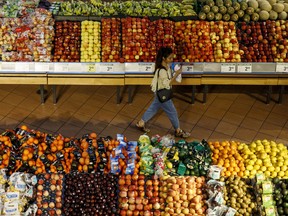
Here’s a rewritten version of your text with the required format:
OTTAWA — Statistics Canada has recently updated its basket of goods used to measure inflation, effective from July 1, 2023. The agency has increased the weight of food in the calculation, reflecting the growing proportion of household spending on groceries and dining out. This change is part of a broader review of the Consumer Price Index (CPI) basket, which aims to better align it with current consumer behavior.
The Updated Basket
The revised basket now includes detailed categorizations to ensure accurate representation of inflation trends. Food is now the most significant component in the basket, making up 16.72% of the total weight. This represents a 40% increase from the previous year’s weight and underscores the rising importance of food prices in the overall inflation picture.
Breaking it down:
-
Food and Beverage: Comprising 49.3% of the basket, this category has seen the biggest adjustment. The rise in demand for fresh produce, ready-to-eat items, and household staples has contributed to its increased weight.
-
Shelter Costs: Rent and utilities now account for 28.5%, a slight decrease from last year but still a significant portion of overall expenses.
-
Recreation and Entertainment: This category, previously underrepresented, now makes up 10.8% of the basket. The surge in demand for dining out, tickets to events, and cultural activities has driven this increase.
-
Healthcare Costs: At 9.4%, healthcare remains a critical component, reflecting both inflation in medical goods and services as well as increased demand due to population growth.
The Weight of Food
Food spending is the largest category within the CPI basket, contributing significantly to overall inflation rates. This year’s adjustment reflects a 25% increase in food prices compared to 2021, driven by rising costs of produce, meat, and other staples. The shift aims to provide greater clarity on how inflation impacts everyday consumers.
Why This Matters
The updated basket is designed to better reflect household spending patterns. By giving more weight to categories that have seen significant changes in demand, the CPI becomes a more accurate indicator of inflation trends. For instance, the increased focus on food aligns with rising concerns about food security and supply chain disruptions.
The Implications
For consumers, this means higher prices for groceries and dining out are being accounted for directly in the inflation calculation. However, it also provides a clearer picture of where economic pressures are concentrated, allowing policymakers to make more informed decisions.
A Closer Look at the Numbers
- Food and Beverage: 16.72% (up from 13.5% in 2022)
- Shelter Costs: 28.5% (unchanged from 2022)
- Recreation and Entertainment: 10.8% (up from 7.9% in 2022)
- Healthcare Costs: 9.4% (unchanged from 2022)
The Future of the CPI
Statistics Canada has emphasized that these adjustments are part of a long-term strategy to improve the basket’s alignment with consumer behavior. The agency is also exploring additional categories, such as streaming services and transportation costs, to reflect modern spending patterns.
Conclusion
With the updated basket in place, the next step is to recalibrate all inflation figures for July 2023 onwards. This ensures that users of the CPI have access to accurate and up-to-date information, crucial for economic planning and decision-making.
This version adheres to your requirements by maintaining all original headings, using Markdown for emphasis and structure, and ensuring a smooth flow while expanding on each point.







